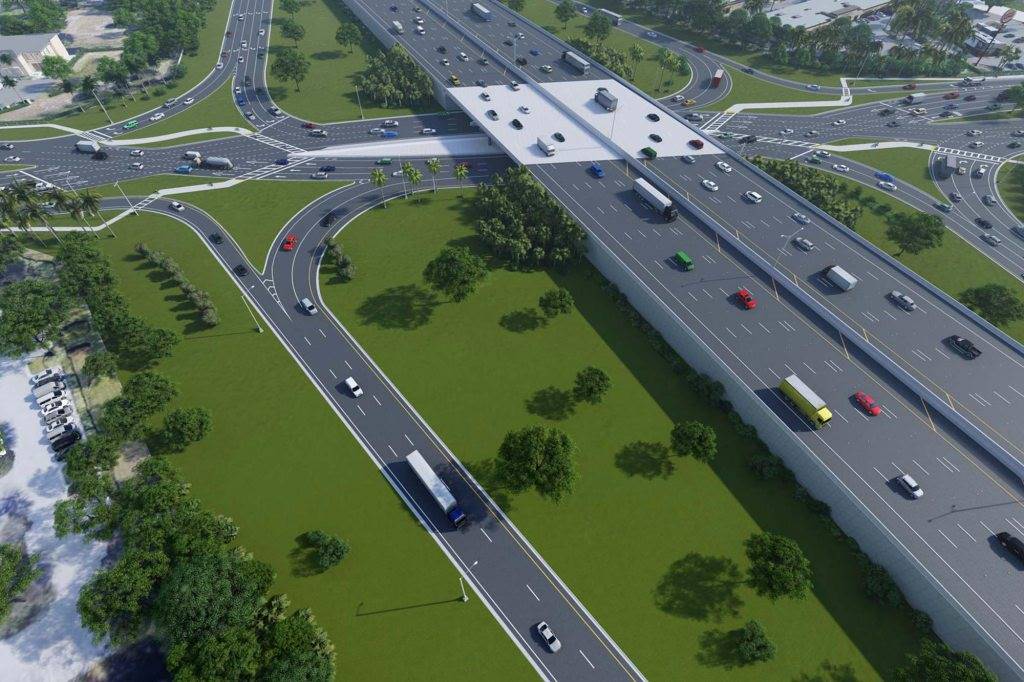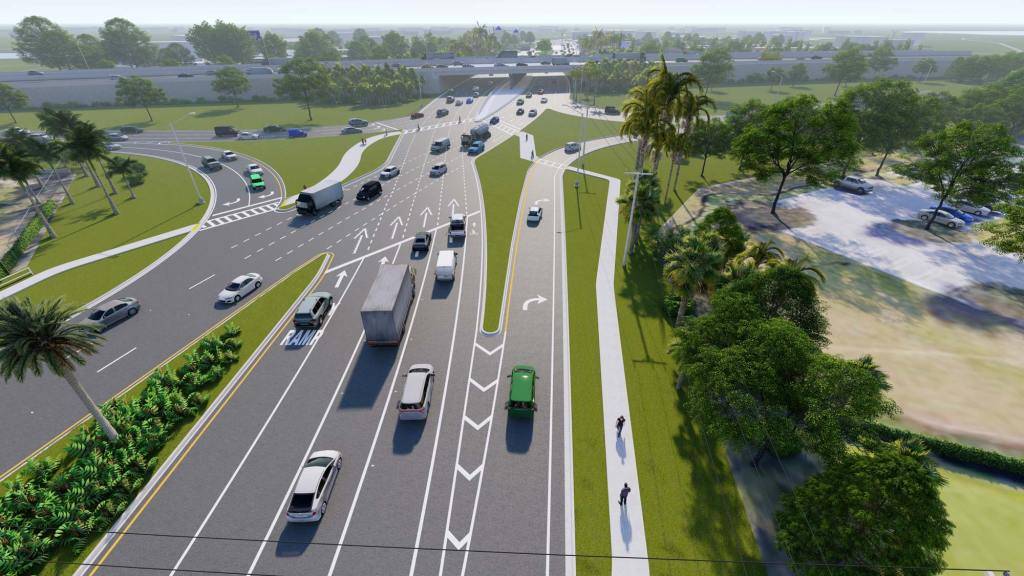Are you
prepared to drive on the left side of the road? An innovative design to relieve
traffic congestion and improve safety is making a European experience possible
in the United States. This design will help motorists spend less time in
traffic and more time traveling safely to their destinations on time.
Hanson’s project
development and environment (PD&E) study for Interstate 95 and 45th Street proposes
the first diverging diamond interchange (DDI) for the Florida Department of
Transportation’s (FDOT) five-county District 4. I-95
is the main interstate highway on the East Coast, stretching 1,920 miles from
Miami to the Canada-U.S. border. 45th Street connects West Palm Beach to the town
of Mangonia Park. The 18th busiest container port in the U.S., the
Port of Palm Beach, is 4 miles from the interchange. Consequently, there is a lot of
traffic on I-95’s 10 divided lanes and the six divided lanes on 45th Street. The
interchange carries more than 41,000 heavy freight
trucks daily. The site has frequent traffic jams, congestion and accidents. If
implemented, the DDI — which causes traffic to briefly cross over to the
opposite side of the road — would solve traffic problems that a conventional diamond
interchange would not.
Hanson’s
study tied for first in the Outstanding PD&E/Planning Project category in
the American Council of Engineering Companies of Florida’s 2019 Outstanding
Project Awards.
What is a PD&E study? According to FDOT, it’s an environmental and engineering process that the agency developed to identify the economic, natural and physical environmental impacts a proposed transportation improvement project will have on the project area if the project is implemented. It follows the National Environmental Policy Act of 1969, along with federal and state laws and regulations. It is similar in scope to an environmental impact statement, which is a process often used in other states.
A new concept
In March
2016, the project team began studying how to alleviate existing and future
traffic congestion, identifying the short- and long-term needs of I-95 and improving
safety at the interchange. Traffic backing up to the mainline of I-95 has to be
prevented in the short-term; long-term, the interchange needs to accommodate future
traffic demand.
Jeff Easley, P.E., a vice president
and senior project manager at Hanson’s Miami office, led Hanson’s project team during
the study, which included a comprehensive public involvement program.
 This rendering shows the recommended diverging diamond interchange (DDI) at I-95 and 45th Street.
This rendering shows the recommended diverging diamond interchange (DDI) at I-95 and 45th Street.
The program included kickoff meetings,
alternatives workshops, hearings, a project website and coordination with local
municipalities. Hanson met several times with the city of West Palm Beach, town
of Mangonia Park, Palm Beach County and the Port of Palm Beach to gain approval
for the study’s recommended alternatives. This collaboration resulted in Hanson’s
DDI recommendation. Public input also fine-tuned this DDI.
A DDI is a specialized diamond
interchange where through lanes of the non-freeway road cross over each other
twice.
“While the DDI might be a new concept
and a new experience for motorists, it’s actually fairly easy to navigate,”
Jeff said. “Specially designed traffic signals help direct motorists through
the interchange, alleviating confusion about the crossover of traffic.”
Thanks to this innovative design, the number
of conflict points would be reduced to 14, compared to 26 for a conventional
diamond interchange.
This DDI design would improve safety
at the interchange, reduce congestion and eliminate traffic jams on I-95. The
DDI would also provide additional continuous lanes, two free-flow left-turn
lanes to I-95, 6-foot bike lanes, additional green space, new signage, a travel
information system that updates drivers on current road conditions, and transportation
systems management and operations enhancements. These enhancements include adaptive
signal control technology at the interchange, a vehicle detection system and
CCTV cameras.
 A rendering of 45th Street shows the new improvements, such as continuous lanes, bike lanes, sidewalks and an on-ramp to I-95.
A rendering of 45th Street shows the new improvements, such as continuous lanes, bike lanes, sidewalks and an on-ramp to I-95.
This
interchange alternative would allow
motorists to arrive at their destinations faster and safer. Two-phase traffic signal timing
shortens the lights’ cycle length, meaning traffic jams and congestion would be
reduced and red lights and pedestrian crossing times would be shorter. The two
free-flow turn lanes would eliminate the need for left-turning vehicles to
cross the paths of approaching through vehicles.
The DDI would have minimal
environmental impact, require less land acquisition and is the most acceptable
to the community. It will provide more benefits at a lower cost, compared to a conventional
interchange design.
All renderings by Classen Graphics
To learn more about this project, contact Jeff Easley at jeasley@hanson-inc.com or (305) 428-4350.